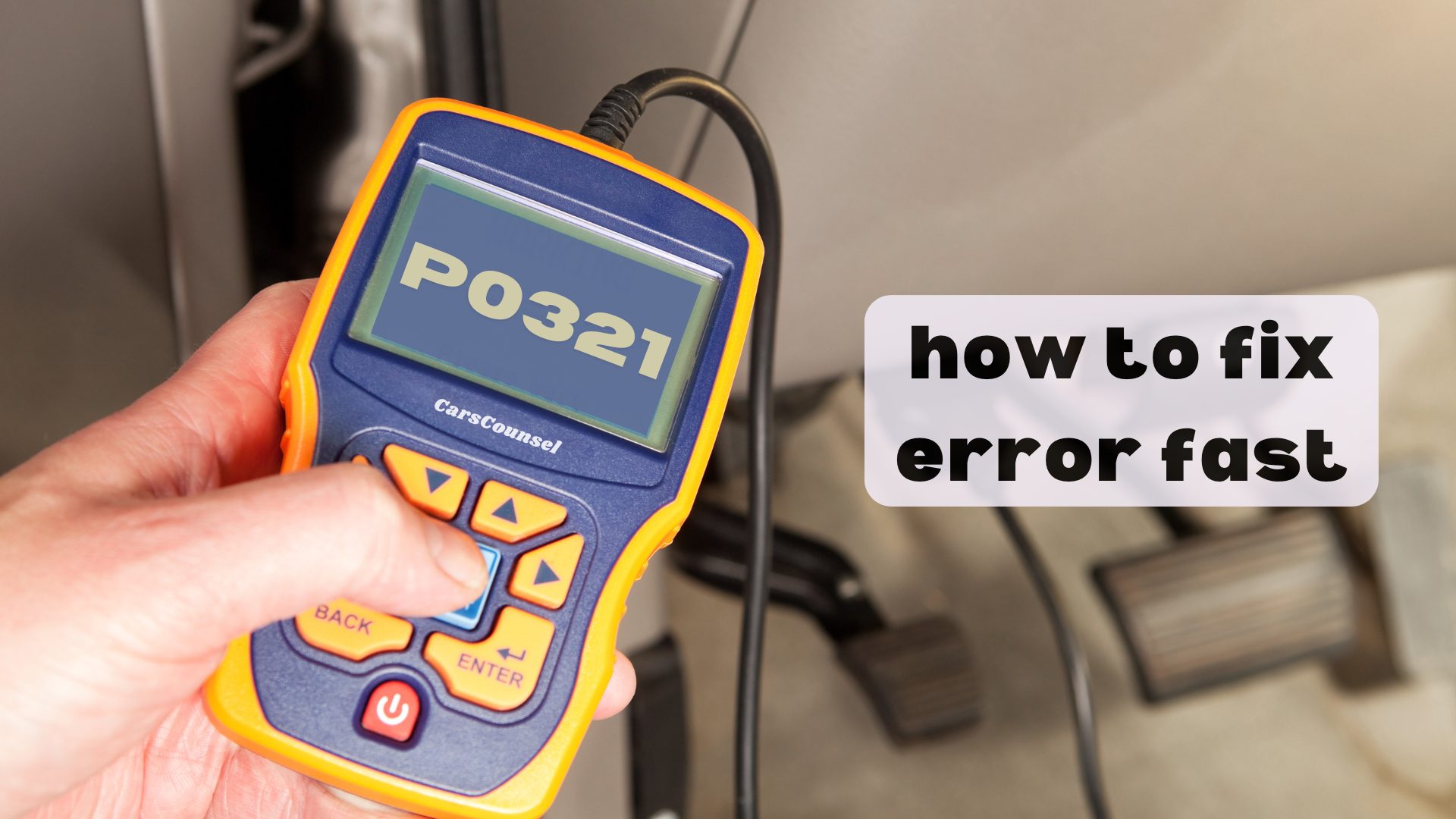Imagine your car’s engine light flashing like a warning signal; that’s what the P0321 code feels like. There’s no need to panic, but you can’t ignore it either.
First, get your OBD-II scanner and confirm the error code—it’s important to know exactly what’s wrong.
Check the crankshaft position sensor for any visible damage or corrosion. If the sensor looks damaged, replacing it might be your quickest fix.
If that doesn’t solve the problem, there’s more to check. What’s the next step? Let’s dig deeper.

Quick Navigation
Key Takeaways
- Take a look at the wiring and connectors to see if they are damaged or corroded.
- Use an OBD-II scanner to verify the P0321 code and look for any related issues.
- Check the crankshaft position sensor to make sure it has the right resistance and voltage.
- Look at the ignition control module to ensure it has the correct voltage and signal output.
Understanding the P0321 Code
Understanding the P0321 code is important because it means there’s a problem with your car’s ignition or engine speed sensor, which can affect how well your engine runs and your overall safety. When the P0321 code shows up, it can cause your engine to idle roughly, misfire, and create safety hazards.
To fix this, start by visually checking the wiring and connectors for any damage or rust. Use an OBD-II scanner to confirm the code and see if there are any other related issues.
Check the crankshaft position sensor with a multimeter to make sure it has the right resistance and voltage. Also, test the ignition control module and ensure the engine control module (ECM) is getting the correct signals.
Taking these steps quickly can help keep your car running well and avoid more problems.
Symptoms of P0321 Code
If you see the P0321 code, you might experience symptoms like rough idling, engine misfires, and difficulty starting your vehicle. These problems can make driving both frustrating and unsafe.
To fix these issues, use a diagnostic tool like an OBD-II scanner to confirm the P0321 code and find any other related codes.
Check the wiring and connectors for any damage or corrosion. Use a multimeter to test the crankshaft position sensor and ignition control module to make sure they’re working properly.
It’s important that your ECM (Engine Control Module) gets the right signals.
Importance of Early Diagnosis
Finding out early if your car has the P0321 code is key to keeping your engine in good shape and running well.
Using modern tools quickly can help you find problems like bad sensors or wiring issues before they get worse. Fixing these issues early ensures your car runs smoothly and helps you avoid expensive repairs later.
Regular car check-ups, including using an OBD-II scanner, help catch problems early. Ignoring issues can lead to major driving problems and higher fuel costs.
Common Causes of P0321
The P0321 code often shows up because the crankshaft position sensor is faulty. This means it’s either sending a weak signal or no signal at all to the car’s computer (ECM). Another common problem is damaged or corroded wiring, which can mess up the signal. The ignition control module might also be broken, sending wrong signals to the ECM. Sometimes, the ECM itself might misread signals from these sensors, causing the code to appear.
| Problem | Fix |
|---|---|
| Bad Crankshaft Sensor | Replace the Sensor |
| Damaged or Corroded Wiring | Repair the Wiring |
| Faulty Ignition Control Module | Replace the Module |
When diagnosing this issue, check these parts carefully to find out what’s wrong. Fixing the right part will help get your car running smoothly again.
Affected Car Models
Several car models, like the Ford F-150, Jeep Grand Cherokee, and Dodge RAM, are more likely to show the P0321 code because of common problems with the crankshaft position sensor. These issues often affect model years from the early 2000s to the latest versions.
If you own one of these vehicles, keep an eye out for symptoms like rough idling and trouble starting. Knowing that these models are prone to this problem can help you stay on top of maintenance.
Regularly checking the crankshaft position sensor and its wiring in these vehicles can prevent the P0321 code from affecting your car’s performance and efficiency.
Performing a Visual Inspection
Start your visual inspection by checking the wiring and connectors for any signs of damage or rust.
Thoroughly look for frayed wires, loose connections, or rust around terminals. Make sure to check for any exposed or pinched wires, as these can mess with the signal to the ECM.
Ensure connectors are firmly in place and dry. Pay extra attention to the wiring of the crankshaft position sensor since it’s often the cause of the P0321 code.
If you find any damaged or rusty parts, fix or replace them right away. This initial check is crucial for accurate diagnostics and prepares you for more detailed tests if needed.
Using an OBD-II Scanner
An OBD-II scanner is a crucial tool for diagnosing car problems, like the P0321 code, and finding any related issues. Knowing the basics of OBD II will help you make an accurate diagnosis.
To start, plug the scanner into your car’s OBD-II port, usually found under the dashboard. Follow the scanner’s instructions to get the trouble codes.
The scanner lets you do several things, such as:
- Read and clear trouble codes
- See live data from sensors
- Run system tests
- View snapshot data
Checking the Crankshaft Position Sensor
To check the crankshaft position sensor, find it near the engine’s crankshaft pulley or flywheel. Start by unplugging the sensor’s electrical connector. Look closely at the sensor and wiring for any damage or rust.
Next, use a multimeter to check the sensor’s resistance. Check your vehicle’s service manual to find out the correct resistance range.
Then, reconnect the sensor and use the multimeter to measure the voltage while you crank the engine. The voltage should go up and down, showing that the sensor is working.
If the resistance or voltage isn’t within the specified range, you’ll need to replace the crankshaft position sensor to fix the P0321 code.
Testing the Ignition Control Module
You’ll often need a multimeter to check if the ignition control module is working correctly. Start by finding the module, which is usually near the engine or under the dashboard.
Here are some steps to test the ignition module:
- Disconnect the Ignition Module: Make sure the engine is turned off before you disconnect it.
- Set Your Multimeter: Put it on the right voltage setting.
- Check for Power: Measure the voltage at the module’s power supply terminal.
- Test Signal Output: Measure the signal voltage while you crank the engine.
Accurate diagnostics are crucial for finding problems and stopping the P0321 code from affecting your vehicle’s performance.
Replacing Faulty Components
When you need to replace faulty parts to fix the P0321 code, start with the crankshaft position sensor since it’s usually the main problem.
Make sure the new sensor matches your vehicle’s make and model. Disconnect the battery to avoid any electrical issues.
Carefully take out the old sensor, paying attention to how it’s positioned and connected. Install the new sensor properly, making sure it’s securely in place and aligned correctly.
Reconnect the wiring without causing any damage. Once everything is set, reconnect the battery and use an OBD-II scanner to clear the code.
Test the vehicle to make sure the problem is fixed. If the issue continues, check the ignition control module and ECM for other problems.
More OBD-II Codes
Frequently Asked Questions
How Much Does It Cost to Repair the P0321 Code?
Fixing the P0321 code can cost anywhere from $100 to $400, depending on the cost of parts and labor. It’s a good idea to use an OBD-II scanner to find out what’s wrong before starting any repairs.
Can I Drive My Car With a P0321 Code?
Driving with a P0321 code is like using a broken compass. Symptoms like rough idling and misfires come from issues like a bad crankshaft sensor. Don’t risk it; get it fixed soon.
How Long Does It Take to Fix the P0321 Code?
Fixing the P0321 code usually takes a few hours. This includes checking the different parts and replacing any faulty ones like the crankshaft position sensor or the ignition control module. The exact time can vary depending on your vehicle and how the diagnostics go.
What Tools Are Needed to Fix the P0321 Code?
You’ll need a diagnostic scanner, a multimeter, and some basic hand tools. Check the ignition system, wiring, and connectors. Test the crankshaft position sensor and ignition control module. Make sure the ECM signals are correct and that the engine timing is accurate.
Are There Any Temporary Fixes for the P0321 Code?
To temporarily fix the P0321 code, you can inspect and clean the connectors, check for loose or damaged wiring, and reset the car’s computer using an OBD-II scanner. These quick fixes can help stabilize the issue until you can get permanent repairs done.
Conclusion
Got a P0321 code? Don’t worry. Grab your OBD-II scanner and start checking things out.
Look at the crankshaft position sensor closely. If it’s not working, just replace it.
Also, check the ignition control module to avoid any more issues.
Once you’ve done that, clear the code and take your car for a drive.
Problem solved, one sensor at a time. Good luck!

